How to eliminate Zephyr miner malware from the operating system
TrojanAlso Known As: Zephyr cryptocurrency miner
Get free scan and check if your device is infected.
Remove it nowTo use full-featured product, you have to purchase a license for Combo Cleaner. Seven days free trial available. Combo Cleaner is owned and operated by RCS LT, the parent company of PCRisk.com.
What kind of malware is Zephyr Miner?
Zephyr Miner is a piece of malicious software classified as a cryptocurrency miner. This malware is designed to mine (i.e., generate) the Zephyr (ZEPH) cryptocurrency for the attackers. Zephyr Miner is a sophisticated cryptominer that exhibits anti-detection and persistence-ensuring capabilities.
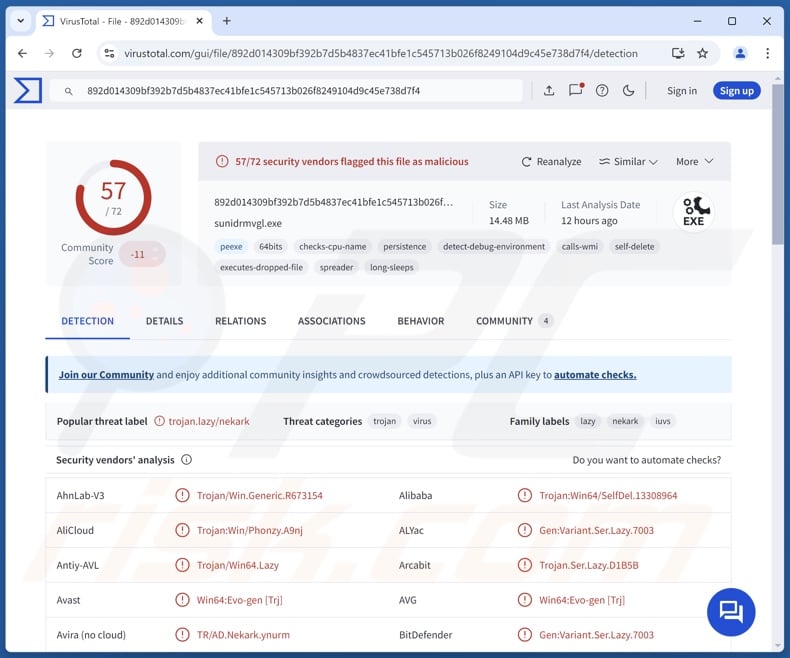
Zephyr Miner malware overview
Zephyr Miner has been observed infiltrating devices using four distinct methods. Each of these different processes is initiated by either a batch file, VBScript (Visual Basic Script) file, PowerShell script, or a Portable Executable file.
Following successful infiltration, this cryptocurrency miner takes action to prevent its detection. This activity includes adding itself to the exclusion list of the Microsoft Defender Antivirus. It also deleted artifacts left over during the infection chain. Additionally, Zephyr Miner uses persistence-ensuring mechanisms, such as setting itself as a scheduled task.
After connecting to its mining pool, Zephyr Miner begins mining the Zephyr (ZEPH) cryptocurrency. This process involves using system resources (like processors [CPUs] and graphics cards [GPUs]) to solve mathematical problems. Zephyr Miner sets the maximum CPU usage to 50%.
The presence of a cryptominer on a device can result in a variety of issues, as the abuse of system resources leads to additional strain on the system, and it may begin "freezing" or crashing. Hence, the computer's performance can be significantly diminished.
What is more, should a miner use a high percentage of system resources, this can produce an excessive amount of heat. Under certain circumstances (such as high room temperatures), the hardware may be damaged. Therefore, cryptocurrency miners can cause data loss, potential privacy issues, and financial losses.
| Name | Zephyr cryptocurrency miner |
| Threat Type | Trojan, cryptocurrency miner, cryptominer, miner. |
| Detection Names | Avast (Win64:Evo-gen [Trj]), Combo Cleaner (Gen:Variant.Ser.Lazy.7003), ESET-NOD32 (A Variant Of Win64/Agent.EVY), Kaspersky (Trojan.Win32.SelfDel.iuvs), Microsoft (Trojan:Win64/Lazy.GTL!MTB), Full List Of Detections (VirusTotal) |
| Symptoms | While trojans are designed to stealthily infiltrate the victim's computer (thus no particular symptoms are clearly visible), miners abuse system resources, which can diminish device performance. |
| Distribution methods | Infected email attachments, malicious online advertisements, social engineering, software 'cracks'. |
| Damage | Victim's computer added to a botnet, diminished system performance, hardware damage, potential privacy issues, financial losses. |
| Malware Removal (Windows) |
To eliminate possible malware infections, scan your computer with legitimate antivirus software. Our security researchers recommend using Combo Cleaner. Download Combo CleanerTo use full-featured product, you have to purchase a license for Combo Cleaner. 7 days free trial available. Combo Cleaner is owned and operated by RCS LT, the parent company of PCRisk.com. |
Cryptocurrency-mining malware examples
We have written about numerous malicious programs; Grand Explorer, SilentCryptoMiner, Altruistics, Kratos Silent Miner, and Sapphire are merely some of our articles on miners.
Malware is a broad term that covers software with a wide variety of capabilities. However, regardless of how a malicious program operates – its presence on a system threatens device integrity and user safety. Therefore, all threats must be eliminated immediately upon detection.
How did Zephyr Miner infiltrate my computer?
The methods used to proliferate Zephyr Miner are currently unknown. Generally, malware is spread by relying on phishing and social engineering techniques. It is usually disguised as or bundled with ordinary programs/media. Virulent files can be executables (.exe, .run, etc.), archives (ZIP, RAR, etc.), documents (PDF, Microsoft Office, Microsoft OneNote, etc.), JavaScript, and so on. Merely opening such a file can be enough to initiate the infection chain.
The most common malware distribution methods include: backdoor/loader-type trojans, drive-by (stealthy/deceptive) downloads, malicious attachments or links in spam emails/messages, untrustworthy download sources (e.g., freeware and third-party websites, P2P sharing networks, etc.), pirated content, online scams, fake updaters, and illegal software activation ("cracking") tools.
Furthermore, some malicious programs can self-proliferate via local networks and removable storage devices (e.g., external hard drives, USB flash drives, etc.).
How to avoid installation of malware?
We strongly recommend being careful while browsing since the Internet is rife with deceptive and malicious content. Incoming emails and other messages must be approached with caution. Attachments or links present in dubious/irrelevant mail must not be opened, as they can be harmful or infectious.
Additionally, all downloads must be performed from official and verified channels. Another recommendation is to activate and update software using functions/tools provided by genuine developers, as those obtained from third-parties can contain malware.
It is paramount for device/user safety to have a reputable anti-virus installed and kept up-to-date. Security programs must be used to run regular system scans and to remove detected threats. If you believe that your computer is already infected, we recommend running a scan with Combo Cleaner Antivirus for Windows to automatically eliminate infiltrated malware.
Instant automatic malware removal:
Manual threat removal might be a lengthy and complicated process that requires advanced IT skills. Combo Cleaner is a professional automatic malware removal tool that is recommended to get rid of malware. Download it by clicking the button below:
DOWNLOAD Combo CleanerBy downloading any software listed on this website you agree to our Privacy Policy and Terms of Use. To use full-featured product, you have to purchase a license for Combo Cleaner. 7 days free trial available. Combo Cleaner is owned and operated by RCS LT, the parent company of PCRisk.com.
Quick menu:
- What is Zephyr Miner?
- STEP 1. Manual removal of Zephyr Miner malware.
- STEP 2. Check if your computer is clean.
How to remove malware manually?
Manual malware removal is a complicated task - usually it is best to allow antivirus or anti-malware programs to do this automatically. To remove this malware we recommend using Combo Cleaner Antivirus for Windows.
If you wish to remove malware manually, the first step is to identify the name of the malware that you are trying to remove. Here is an example of a suspicious program running on a user's computer:
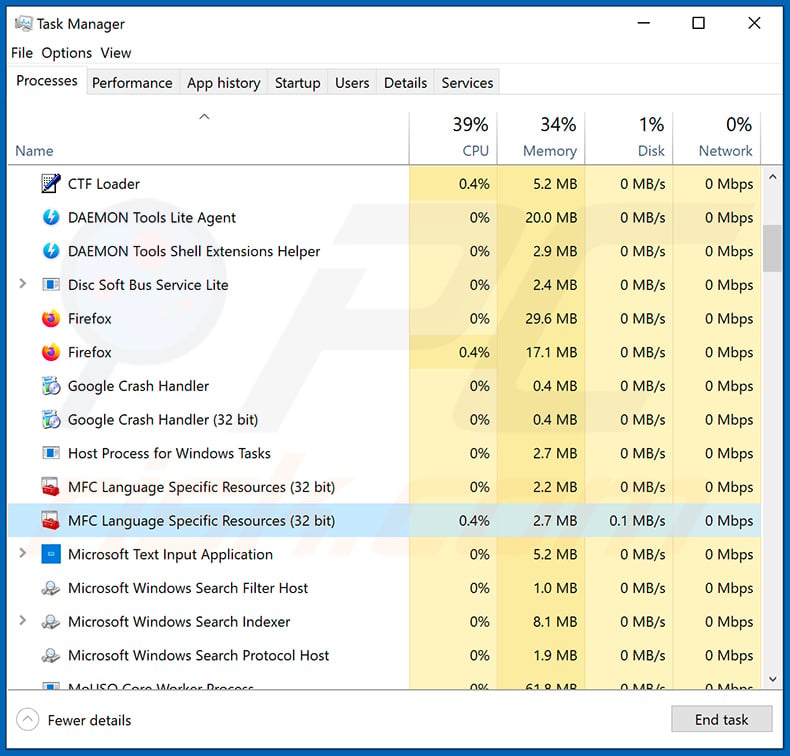
If you checked the list of programs running on your computer, for example, using task manager, and identified a program that looks suspicious, you should continue with these steps:
 Download a program called Autoruns. This program shows auto-start applications, Registry, and file system locations:
Download a program called Autoruns. This program shows auto-start applications, Registry, and file system locations:
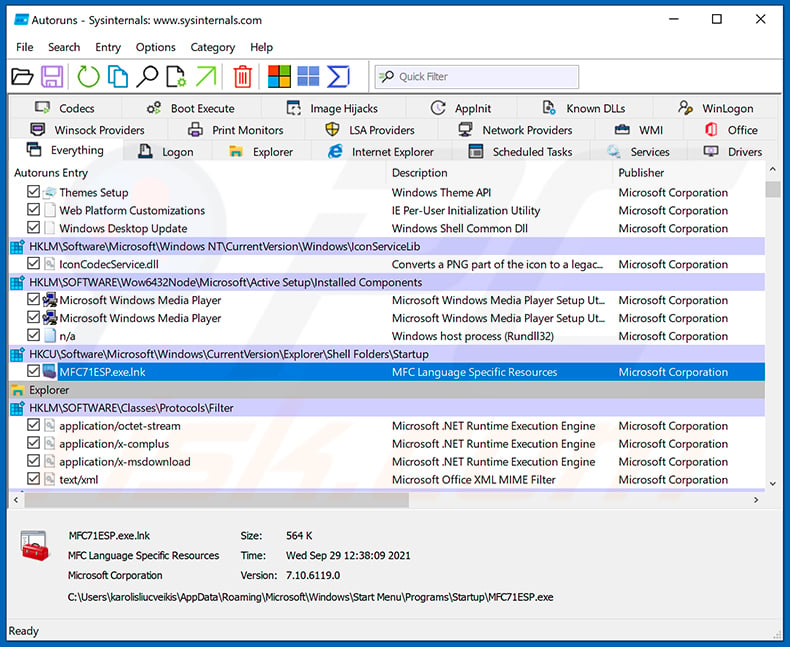
 Restart your computer into Safe Mode:
Restart your computer into Safe Mode:
Windows XP and Windows 7 users: Start your computer in Safe Mode. Click Start, click Shut Down, click Restart, click OK. During your computer start process, press the F8 key on your keyboard multiple times until you see the Windows Advanced Option menu, and then select Safe Mode with Networking from the list.
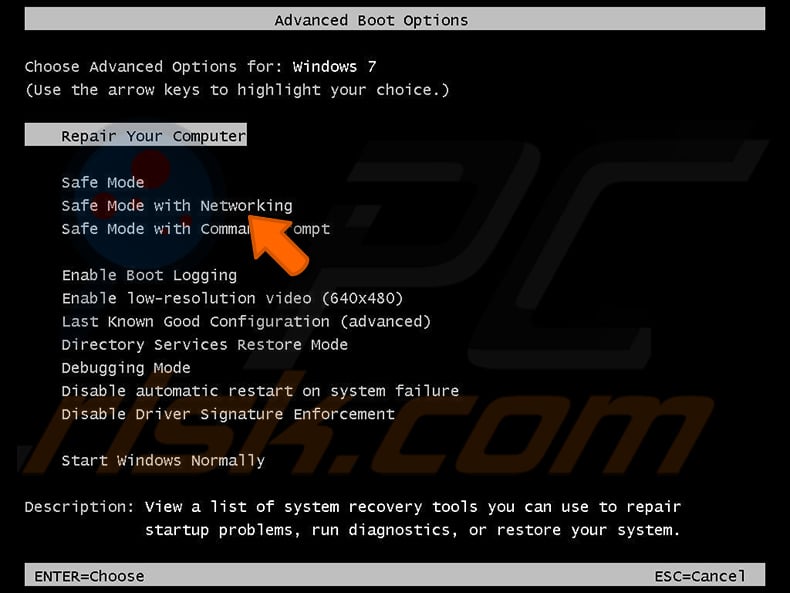
Video showing how to start Windows 7 in "Safe Mode with Networking":
Windows 8 users: Start Windows 8 is Safe Mode with Networking - Go to Windows 8 Start Screen, type Advanced, in the search results select Settings. Click Advanced startup options, in the opened "General PC Settings" window, select Advanced startup.
Click the "Restart now" button. Your computer will now restart into the "Advanced Startup options menu". Click the "Troubleshoot" button, and then click the "Advanced options" button. In the advanced option screen, click "Startup settings".
Click the "Restart" button. Your PC will restart into the Startup Settings screen. Press F5 to boot in Safe Mode with Networking.
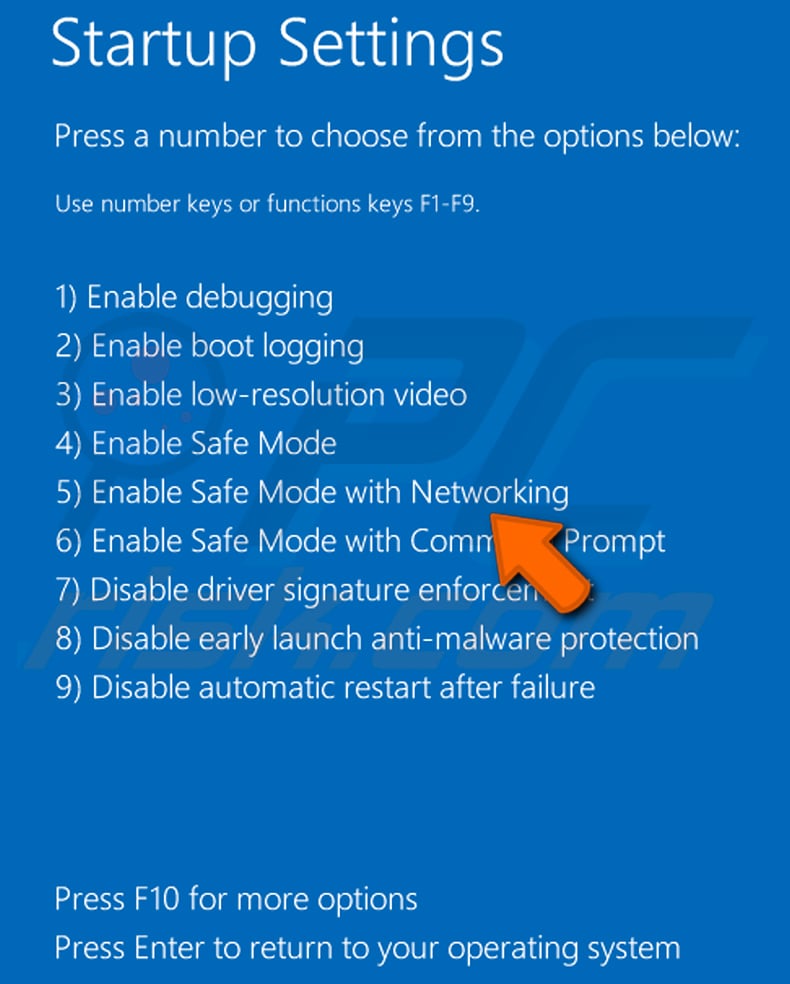
Video showing how to start Windows 8 in "Safe Mode with Networking":
Windows 10 users: Click the Windows logo and select the Power icon. In the opened menu click "Restart" while holding "Shift" button on your keyboard. In the "choose an option" window click on the "Troubleshoot", next select "Advanced options".
In the advanced options menu select "Startup Settings" and click on the "Restart" button. In the following window you should click the "F5" button on your keyboard. This will restart your operating system in safe mode with networking.
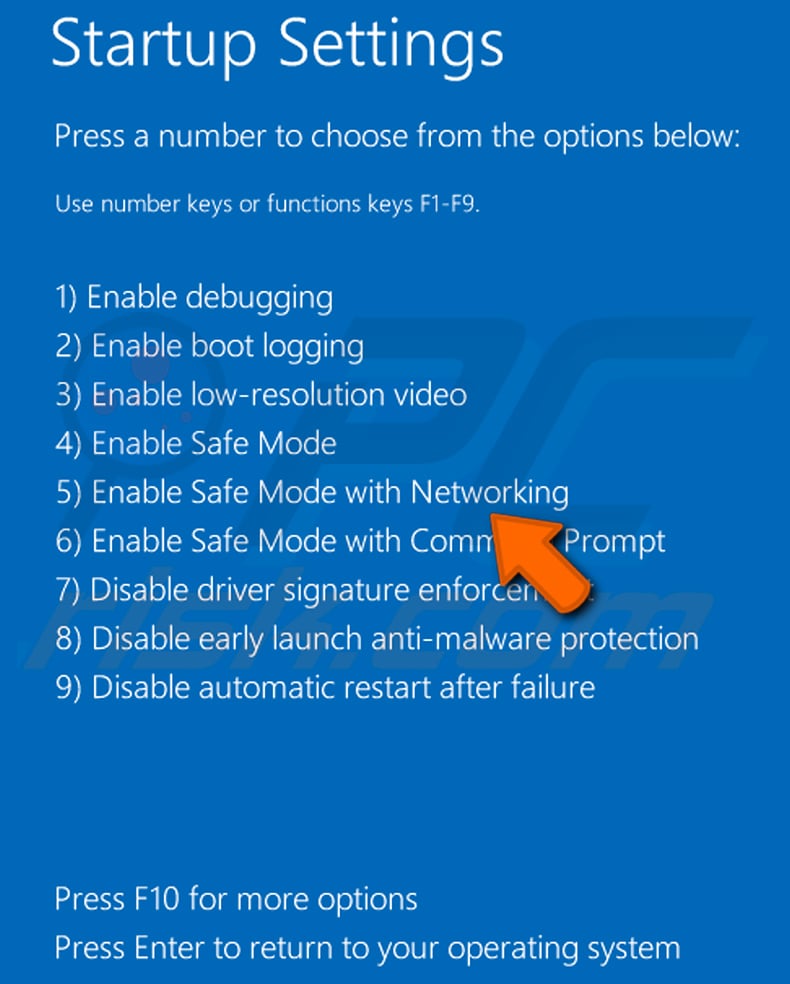
Video showing how to start Windows 10 in "Safe Mode with Networking":
 Extract the downloaded archive and run the Autoruns.exe file.
Extract the downloaded archive and run the Autoruns.exe file.
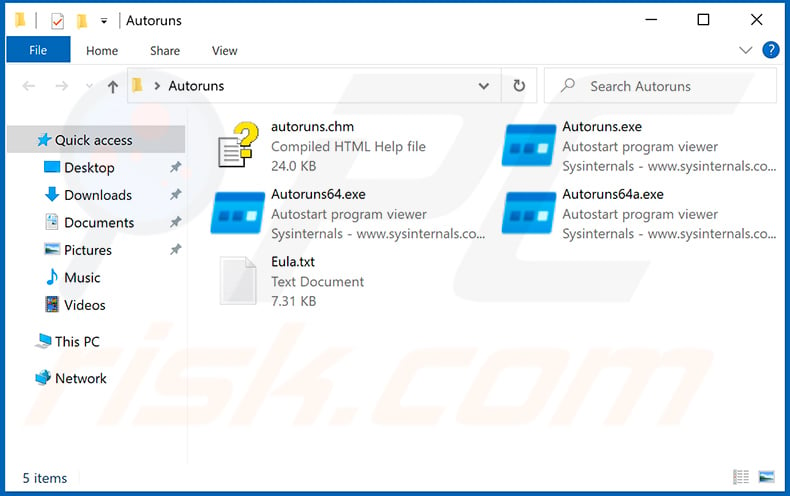
 In the Autoruns application, click "Options" at the top and uncheck "Hide Empty Locations" and "Hide Windows Entries" options. After this procedure, click the "Refresh" icon.
In the Autoruns application, click "Options" at the top and uncheck "Hide Empty Locations" and "Hide Windows Entries" options. After this procedure, click the "Refresh" icon.
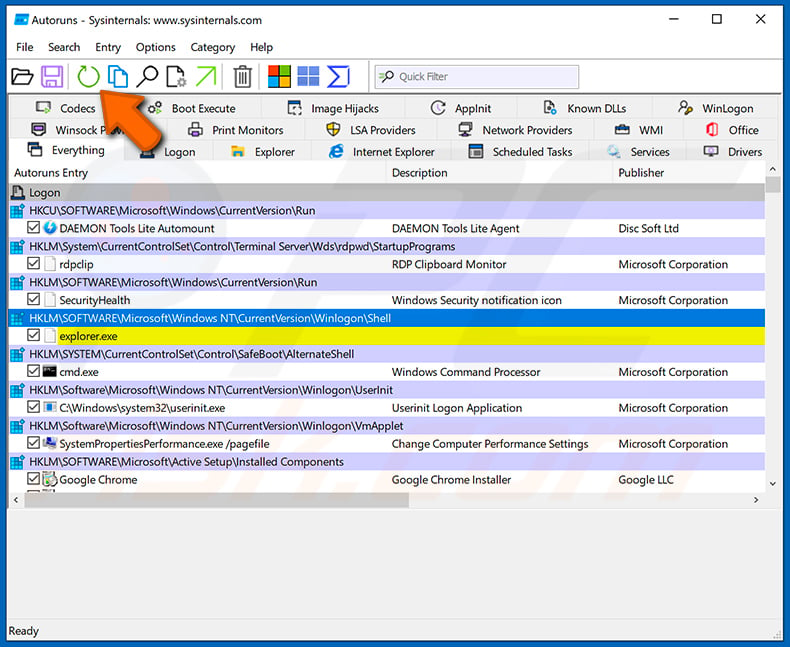
 Check the list provided by the Autoruns application and locate the malware file that you want to eliminate.
Check the list provided by the Autoruns application and locate the malware file that you want to eliminate.
You should write down its full path and name. Note that some malware hides process names under legitimate Windows process names. At this stage, it is very important to avoid removing system files. After you locate the suspicious program you wish to remove, right click your mouse over its name and choose "Delete".
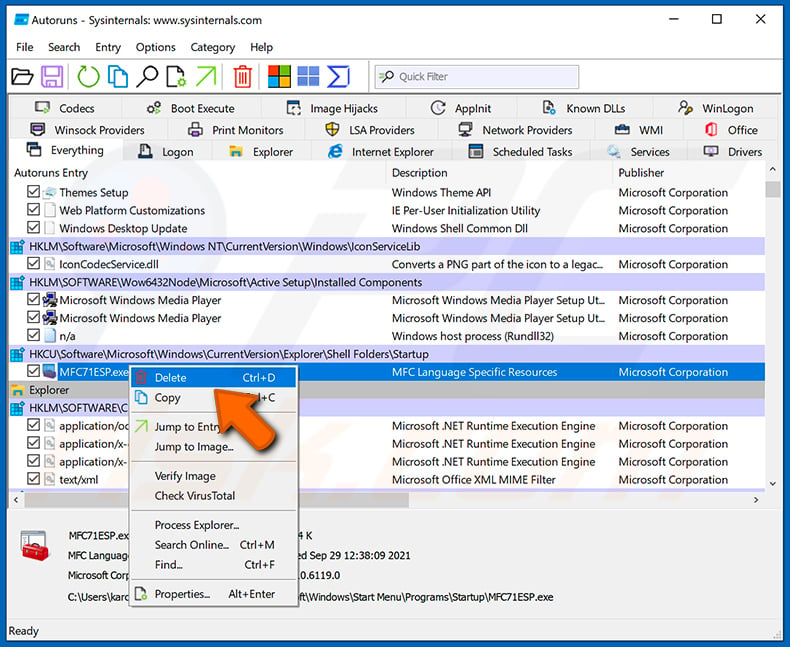
After removing the malware through the Autoruns application (this ensures that the malware will not run automatically on the next system startup), you should search for the malware name on your computer. Be sure to enable hidden files and folders before proceeding. If you find the filename of the malware, be sure to remove it.
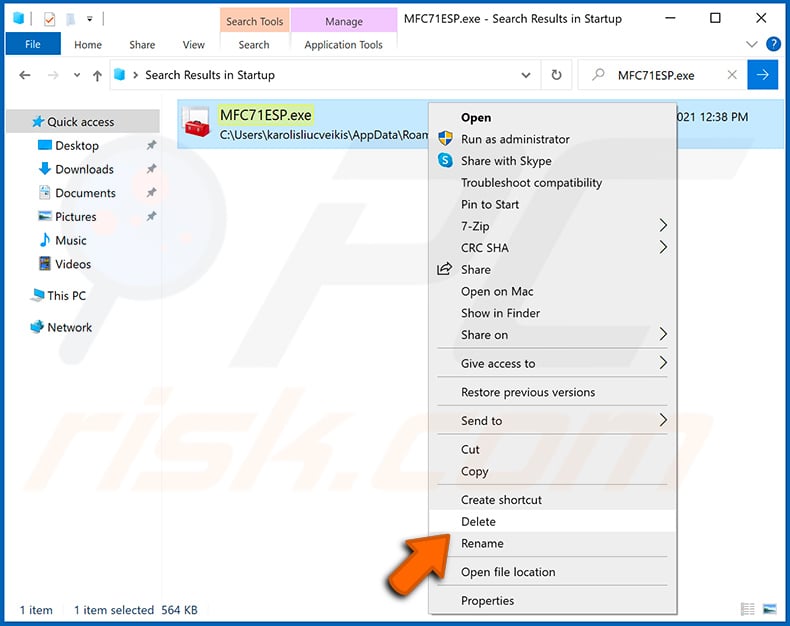
Reboot your computer in normal mode. Following these steps should remove any malware from your computer. Note that manual threat removal requires advanced computer skills. If you do not have these skills, leave malware removal to antivirus and anti-malware programs.
These steps might not work with advanced malware infections. As always it is best to prevent infection than try to remove malware later. To keep your computer safe, install the latest operating system updates and use antivirus software. To be sure your computer is free of malware infections, we recommend scanning it with Combo Cleaner Antivirus for Windows.
Frequently Asked Questions (FAQ)
My computer is infected with Zephyr Miner malware, should I format my storage device to get rid of it?
Malware removal seldom requires formatting.
What are the biggest issues that Zephyr Miner malware can cause?
The dangers posed by an infection depend on the malicious program's capabilities and the cyber criminals' goals. Zephyr Miner is a miner – a type of malware designed to generate cryptocurrency by abusing system resources. Infections of this kind can lead to diminished system performance, data loss, potential privacy issues, hardware damage, and financial losses.
What is the purpose of Zephyr Miner malware?
Profit is the most common motivation behind malware attacks, and based on Zephyr Miner's abilities – it is not an exception. However, cyber criminals can use malicious software for other reasons, such as to amuse themselves, carry out personal vendettas, disrupt processes (e.g., sites, services, companies, etc.), engage in hacktivism, and launch politically/geopolitically motivated attacks.
How did Zephyr Miner malware infiltrate my computer?
Malware is predominantly spread via trojans, drive-by downloads, spam mail, online scams, suspicious download channels (e.g., unofficial and free file-hosting sites, Peer-to-Peer sharing networks, etc.), pirated content, fake updaters, and illegal software activation ("cracking") tools. Some malicious programs can even self-spread through local networks and removable storage devices.
Will Combo Cleaner protect me from malware?
Combo Cleaner can detect and eliminate practically all known malware infections. Note that high-end malicious software typically hides deep within systems – therefore, performing a complete system scan is crucial.
Share:

Tomas Meskauskas
Expert security researcher, professional malware analyst
I am passionate about computer security and technology. I have an experience of over 10 years working in various companies related to computer technical issue solving and Internet security. I have been working as an author and editor for pcrisk.com since 2010. Follow me on Twitter and LinkedIn to stay informed about the latest online security threats.
PCrisk security portal is brought by a company RCS LT.
Joined forces of security researchers help educate computer users about the latest online security threats. More information about the company RCS LT.
Our malware removal guides are free. However, if you want to support us you can send us a donation.
DonatePCrisk security portal is brought by a company RCS LT.
Joined forces of security researchers help educate computer users about the latest online security threats. More information about the company RCS LT.
Our malware removal guides are free. However, if you want to support us you can send us a donation.
Donate
▼ Show Discussion